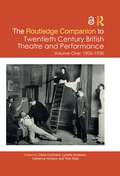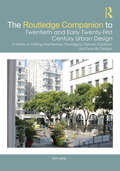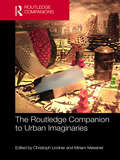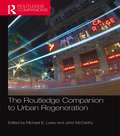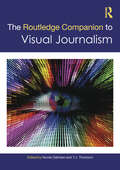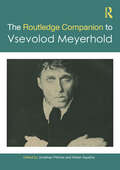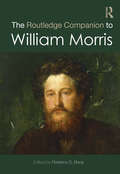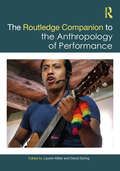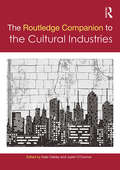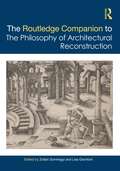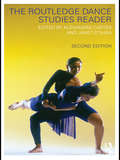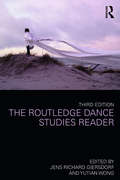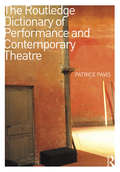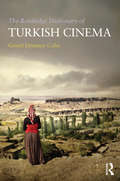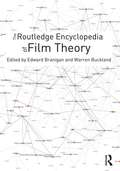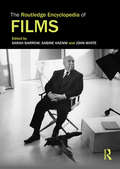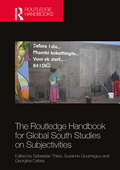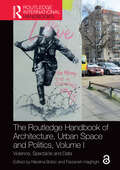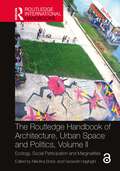- Table View
- List View
The Routledge Companion to Twentieth Century British Theatre and Performance: Volume One: 1900–1950 (Routledge Companions)
by Lynette Goddard Trish Reid Claire Cochrane Catherine HindsonThe Routledge Companion to Twentieth Century British Theatre and Performance provides a broad range of perspectives on the multiple models and examples of theatre, artists, enthusiasts, enablers, and audiences that emerged over this formative 100-year period.This first volume covers the first half of the century, constructing an equitable and inclusive history that is more representative of the nation's lived experience than the traditional narratives of British theatre. Its approach is intra-national – weaving together the theatres and communities of England, Scotland, Wales, and Northern Ireland. The essays are organised thematically arranged into sections that address nation, power, and identity; fixity and mobility; bodies in performance; the materiality of theatre and communities of theatre. This approach highlights the synergies, convergences, and divergences of the theatre landscape in Britain during this period, giving a sense of the sheer variety of performance that was taking place at any given moment in time.This is a fascinating and indispensable resource for undergraduate and graduate students, postgraduate researchers, and scholars across theatre and performance studies, cultural studies, and twentieth-century history.
The Routledge Companion to Twentieth and Early Twenty-First Century Urban Design: A History of Shifting Manifestoes, Paradigms, Generic Solutions, and Specific Designs (Routledge Companions)
by Jon LangThe Routledge Companion to Twentieth and Early Twenty-First Century Urban Design is a fully illustrated descriptive and explanatory history of the development of urban design ideas and paradigms of the past 150 years. The ideas and projects, hypothetical and built, range in scale from the city to the urban block level. The focus is on where the generic ideas originated, the projects that were designed following their precepts, the functions they address and/or afford, and what we can learn from them. The morphology of a city—its built environment—evolves unselfconsciously as private and governmental investors self-consciously erect buildings and infrastructure in a pragmatic, piecemeal manner to meet their own ends. Philosophers, novelists, architects, and social scientists have produced myriad ideas about the nature of the built environment that they consider to be superior to those forms resulting from a laissez-faire attitude to urban development. Rationalist theorists dream of ideal futures based on assumptions about what is good; empiricists draw inspirations from what they perceive to be working well in existing situations. Both groups have presented their advocacies in manifestoes and often in the form of generic solutions or illustrative designs. This book traces the history of these ideas and will become a standard reference for scholars and students interested in the history of urban spaces, including architects, planners, urban historians, urban geographers, and urban morphologists.
The Routledge Companion to Urban Imaginaries (Routledge International Handbooks)
by Christoph Lindner Miriam MeissnerThe Routledge Companion to Urban Imaginaries delves into examples of urban imaginaries across multiple media and geographies: from new visions of smart, eco, and resilient cities to urban dystopias in popular culture; from architectural renderings of starchitecture and luxury living to performative activism for new spatial justice; and from speculative experiments in urban planning, fiction, and photography to augmented urban realities in crowd-mapping and mobile apps. The volume brings various global perspectives together and into close dialogue to offer a broad, interdisciplinary, and critical overview of the current state of research on urban imaginaries. Questioning the politics of urban imagination, the companion gives particular attention to the role that urban imaginaries play in shaping the future of urban societies, communities, and built environments. Throughout the companion, issues of power, resistance, and uneven geographical development remain central. Adopting a transnational perspective, the volume challenges research on urban imaginaries from the perspective of globalization and postcolonial studies, inviting critical reconsiderations of urbanism in its diverse current forms and definitions. In the process, the companion explores issues of Western-centrism in urban research and design, and accommodates current attempts to radically rethink urban form and experience. This is an essential resource for scholars and graduate researchers in the fields of urban planning and architecture; art, media, and cultural studies; film, visual, and literary studies; sociology and political science; geography; and anthropology.
The Routledge Companion to Urban Regeneration
by John McCarthy Michael E. LearyIn the past decade, urban regeneration policy makers and practitioners have faced a number of difficult challenges, such as sustainability, budgetary constraints, demands for community involvement and rapid urbanization in the Global South. Urban regeneration remains a high profile and important field of government-led intervention, and policy and practice continue to adapt to the fresh challenges and opportunities of the 21st century, as well as confronting long standing intractable urban problems and dilemmas. This Companion provides cutting edge critical review and synthesis of recent conceptual, policy and practical developments within the field. With contributions from 70 international experts within the field, it explores the meaning of ‘urban regeneration’ in differing national contexts, asking questions and providing informed discussion and analyses to illuminate how an apparently disparate field of research, policy and practice can be rendered coherent, drawing out common themes and significant differences. The Companion is divided into six sections, exploring: globalization and neo-liberal perspectives on urban regeneration; emerging reconceptualizations of regeneration; public infrastructure and public space; housing and cosmopolitan communities; community centred regeneration; and culture-led regeneration. The concluding chapter considers the future of urban regeneration and proposes a nine-point research agenda. This Companion assembles a diversity of approaches and insights in one comprehensive volume to provide a state of the art review of the field. It is a valuable resource for both advanced undergraduate and postgraduate students in Urban Planning, Built Environment, Urban Studies and Urban Regeneration, as well as academics, practitioners and politicians.
The Routledge Companion to Visual Journalism (Routledge Journalism Companions)
by T. J. Thomson Nicole DahmenRepresenting the first collection of its kind, The Routledge Companion to Visual Journalism introduces fundamental topics and ideas, delineates the diversity and complexity of this growing field, and creates a foundation for future scholarship and study.In the contemporary digital media landscape, still and moving images, interactive visualizations and virtual reality are increasingly important to attract attention, cultivate engagement, inform and influence opinions, and provide a more emotive and immediate viewing experience for news audiences. This Companion draws together leading voices from academia and industry to survey this dynamic and ubiquitous mode and inspire dialogue. Along with an introduction and conclusion, the volume is structured in five sections and covers people and identities; practices and processes; technologies, equipment, and forms; theories, concepts, and values; and audience interpretation and impact. Beginning by looking at the history of visual news, chapters go on to explore how visual news is created; how journalists visually represent gender, race, sexuality, (dis)ability, "elites," and ordinary citizens; key ethical ideas and theories behind the creation of visual news; and how visual news is processed, drawing in research from eye-tracking, media psychology, and media literacy. The book ends with a critical look at the future of the field.The Routledge Companion to Visual Journalism is a recommended resource for all advanced students and researchers of visual journalism and communication and will also be of interest to practitioners in these fields.
The Routledge Companion to Vsevolod Meyerhold (Routledge Companions)
by Jonathan Pitches Stefan AquilinaThe Routledge Companion to Vsevolod Meyerhold brings together a wealth of scholarship on one of the foremost innovators in European theatre. It presents a detailed picture of the Russian director’s work from when it first emerged on the modern stage to its multifarious present-day manifestations. By combining an historical focus with the latest contemporary research from an international range of perspectives and authors, this collection marks an important moment in Meyerhold studies as well as offering a new assessment of his relation to today's theatre-making. Its dynamic blend of research is presented in five sections: Histories enlarges on more conventional subjects like the grotesque and Biomechanics, to overlooked topics such as Meyerhold's ‘failed’ projects and his work in film; Collaborations and Connections extends understandings of Meyerhold’s well-known collaborative capacities to consider new cultural influences and lesser known working relationships; Sources engages with hitherto untapped material in Meyerhold’s oeuvre by reproducing and contextualising previously untranslated primary sources on his work; Practitioner Voices offer lively, on the ground, testimony of the contemporary impact of Meyerhold's practice; Meyerhold in New Contexts maps the routes of his practice across continents and examines ways in which his work is being applied in a number of contemporary scenarios, such as motion capture, computer-based 3D visualisations, and the ‘new normal’ of digital pedagogy. This is a key resource for students and scholars of European Theatre, acting theory, and actor training, as well as for those more broadly interested in the socio-political impact of theatre.
The Routledge Companion to William Morris (Routledge Art History and Visual Studies Companions)
by Florence S. BoosWilliam Morris (1834–96) was an English poet, decorative artist, translator, romance writer, book designer, preservationist, socialist theorist, and political activist, whose admirers have been drawn to the sheer intensity of his artistic endeavors and efforts to live up to radical ideals of social justice. This Companion draws together historical and critical responses to the impressive range of Morris’s multi-faceted life and activities: his homes, travels, family, business practices, decorative artwork, poetry, fantasy romances, translations, political activism, eco-socialism, and book collecting and design. Each chapter provides valuable historical and literary background information, reviews relevant opinions on its subject from the late-nineteenth century to the present, and offers new approaches to important aspects of its topic. Morris’s eclectic methodology and the perennial relevance of his insights and practice make this an essential handbook for those interested in art history, poetry, translation, literature, book design, environmentalism, political activism, and Victorian and utopian studies.
The Routledge Companion to William Morris (Routledge Art History and Visual Studies Companions)
by Florence S. BoosWilliam Morris (1834–96) was an English poet, decorative artist, translator, romance writer, book designer, preservationist, socialist theorist, and political activist, whose admirers have been drawn to the sheer intensity of his artistic endeavors and efforts to live up to radical ideals of social justice. This Companion draws together historical and critical responses to the impressive range of Morris’s multi-faceted life and activities: his homes, travels, family, business practices, decorative artwork, poetry, fantasy romances, translations, political activism, eco-socialism, and book collecting and design. Each chapter provides valuable historical and literary background information, reviews relevant opinions on its subject from the late-nineteenth century to the present, and offers new approaches to important aspects of its topic. Morris’s eclectic methodology and the perennial relevance of his insights and practice make this an essential handbook for those interested in art history, poetry, translation, literature, book design, environmentalism, political activism, and Victorian and utopian studies.
The Routledge Companion to Women in Architecture
by Anna SokolinaThe Routledge Companion to Women in Architecture illuminates the names of pioneering women who over time continue to foster, shape, and build cultural, spiritual, and physical environments in diverse regions around the globe. It uncovers the remarkable evolution of women’s leadership, professional perspectives, craftsmanship, and scholarship in architecture from the preindustrial age to the present. The book is organized chronologically in five parts, outlining the stages of women’s expanding engagement, leadership, and contributions to architecture through the centuries. It contains twenty-nine chapters written by thirty-three recognized scholars committed to probing broader topographies across time and place and presenting portraits of practicing architects, leaders, teachers, writers, critics, and other kinds of professionals in the built environment. The intertwined research sets out debates, questions, and projects around women in architecture, stimulates broader studies and discussions in emerging areas, and becomes a catalyst for academic programs and future publications on the subject. The novelty of this volume is in presenting not only a collection of case studies but in broadening the discipline by advancing an incisive overview of the topic as a whole. It is an invaluable resource for architectural historians, academics, students, and professionals.
The Routledge Companion to Women in Architecture
by Anna SokolinaThe Routledge Companion to Women in Architecture illuminates the names of pioneering women who over time continue to foster, shape, and build cultural, spiritual, and physical environments in diverse regions around the globe. It uncovers the remarkable evolution of women’s leadership, professional perspectives, craftsmanship, and scholarship in architecture from the preindustrial age to the present.The book is organized chronologically in five parts, outlining the stages of women’s expanding engagement, leadership, and contributions to architecture through the centuries. It contains twenty-nine chapters written by thirty-three recognized scholars committed to probing broader topographies across time and place and presenting portraits of practicing architects, leaders, teachers, writers, critics, and other kinds of professionals in the built environment. The intertwined research sets out debates, questions, and projects around women in architecture, stimulates broader studies and discussions in emerging areas, and becomes a catalyst for academic programs and future publications on the subject.The novelty of this volume is in presenting not only a collection of case studies but in broadening the discipline by advancing an incisive overview of the topic as a whole. It is an invaluable resource for architectural historians, academics, students, and professionals.
The Routledge Companion to the Anthropology of Performance (Routledge Companions)
by Lauren Miller David SyringThe Routledge Companion to the Anthropology of Performance provides a cutting-edge, comprehensive overview of the foundations, epistemologies, methodologies, key topics and current debates, and future directions in the field. It brings together work from the disciplines of anthropology and performance studies, as well as adjacent fields. Across 31 chapters, a diverse range of international scholars cover topics including: - Ritual - Theater - Storytelling - Music - Dance - Textiles - Land Acknowledgments - Indigenous Identity - Visual Arts - Embodiment - Cognition - Healing - Festivals - Politics - Activism - The Law - Race and Ethnicity - Gender and Sexuality - Class - Religion, Spirituality, and Faith - Disability - Leisure, Gaming, and Sport. In addition, the included Appendix offers tools, exercises, and activities designed by contributors as useful suggestions to readers, both within and beyond academic contexts, to take the insights of performance anthropology into their work. This is a valuable reference for scholars and upper-level students in anthropology, performance studies, and related disciplines, including religious studies, art, philosophy, history, political science, gender studies, and education.
The Routledge Companion to the Anthropology of Performance (Routledge Companions)
by Lauren Miller David SyringThe Routledge Companion to the Anthropology of Performance provides a cutting-edge, comprehensive overview of the foundations, epistemologies, methodologies, key topics and current debates, and future directions in the field. It brings together work from the disciplines of anthropology and performance studies, as well as adjacent fields. Across 31 chapters, a diverse range of international scholars cover topics including: Ritual Theater Storytelling Music Dance Textiles Land Acknowledgments Indigenous Identity Visual Arts Embodiment Cognition Healing Festivals Politics Activism The Law Race and Ethnicity Gender and Sexuality Class Religion, Spirituality, and Faith Disability Leisure, Gaming, and Sport In addition, the included Appendix offers tools, exercises, and activities designed by contributors as useful suggestions to readers, both within and beyond academic contexts, to take the insights of performance anthropology into their work. This is a valuable reference for scholars and upper-level students in anthropology, performance studies, and related disciplines, including religious studies, art, philosophy, history, political science, gender studies, and education.
The Routledge Companion to the Cultural Industries (Routledge Media and Cultural Studies Companions)
by Kate Oakley Justin O'ConnorThe Routledge Companion to the Cultural Industries is collection of contemporary scholarship on the cultural industries and seeks to re-assert the importance of cultural production and consumption against the purely economic imperatives of the ‘creative industries’. Across 43 chapters drawn from a wide range of geographic and disciplinary perspectives, this comprehensive volume offers a critical and empirically-informed examination of the contemporary cultural industries. A range of cultural industries are explored, from videogames to art galleries, all the time focussing on the culture that is being produced and its wider symbolic and socio-cultural meaning. Individual chapters consider their industrial structure, the policy that governs them, their geography, the labour that produces them, and the meaning they offer to consumers and participants. The collection also explores the historical dimension of cultural industry debates providing context for new readers, as well as critical orientation for those more familiar with the subject. Questions of industry structure, labour, place, international development, consumption and regulation are all explored in terms of their historical trajectory and potential future direction. By assessing the current challenges facing the cultural industries this collection of contemporary scholarship provides students and researchers with an essential guide to key ideas, issues, concepts and debates in the field.
The Routledge Companion to the Philosophy of Architectural Reconstruction
by Lisa Giombini Zoltán SomhegyiThis companion investigates the philosophical and theoretical foundations determining the conditions of possibility and the limits that make the conservation, readaptation, and transformation of past buildings legitimate operations.As increasing ecological and economic challenges question opportunities for new construction, the process of restoring, transforming, and readapting buildings for new or continued use is becoming an essential part of architectural practice. At the same time, the role of building conservation is changing from mere material preservation to being part of a broader strategy for social regeneration, eco-awareness, and inclusive urban planning. Chapters of this volume explore the complex set of considerations that inform decisions to merely preserve, accurately restore or variously reuse a building. They also look at the broader philosophical concerns such as ethical and aesthetic values, combined with ideas of heritage, history, and collective identity. Case studies on reconstruction after war, gentrification, the restoration of ancient edifices, reconstruction following the effects of climate change, and the use of technology solutions among many others, make this a timely and urgent volume.Adopting a broad transcultural perspective with contributions from five continents, the volume combines theoretical approaches with more practical, case study-based investigations and will be of great interest to upper-level students and academics working in the fields of architecture, conservation, urban design, aesthetics, and heritage management.
The Routledge Companion to the Sound of Space (Routledge International Handbooks)
by Mark Taylor Raj Patel Jeff Malpas Paul Carter Mark Burry Lawrence Harvey Jane Burry Philip Coleman David Buck David Toop Jordan Lacey Wes McGee Gascia Ouzounian Emma Margetson Emma-Kate Matthews Pantea Alambeigi Sven Anderson Paul Bavister Zackery Belanger John Levack Drever Sasha Elina Stuart Favilla’s Iain Forsyth & Jane Pollard Michael Fowler Raviv Ganchrow Nina Garthwaite Philip Jackson Ildar Khannanov Emil Kraugerud Fabricio Mattos Angela McArthur Ben McDonnell Carla Molinari Shane Myrbeck Catie Newell Pedro Novo Eleni-Ira Panourgia Rosalind Parker Philip Samartzis Gerriet K. Sharma Jonathan Tyrrell Gerrie Van Noord Cobi Van Tonder Jan St. Werner Sipei ZhaoThis companion explores a range of conceptual and practical relationships between sound and space across various disciplines, providing insights from technical, creative, cultural, political, philosophical, psychological, and physiological perspectives. The content spans a wide range of spatial typologies, from large reverberant buildings to modest and intimate ones, from external public squares to domestic interiors, and from naturally formed environments to highly engineered spaces. These compiled insights and observations explore the vast diversity of ways in which sonic and spatial realms interact.This publication therefore forms important bridges between the intricate and diverse topics of technology, philosophy, composition, performance, and spatial design, to contemplate the potential of sound and space as tools for creative expression and communication, as well as for technical innovation. It is hoped that by sharing these insights, this book will inspire practitioners, scholars, and enthusiasts to incorporate new perspectives and methodologies into their own work.Through a rich blend of theory, practice, and critical reflection, this volume serves as a valuable resource for anyone interested in exploring the intricacy of relationships between space and sound, whether they are students, professionals, or simply curious. Our companion provides a cross-section through shared territories between sonic and spatial disciplines from architecture, engineering, sound design, music composition and performance, urban design, product design, and much more.
The Routledge Dance Studies Reader
by Janet O'Shea Alexandra CarterThe second edition of The Routledge Dance Studies Reader offers fresh critical perspectives on classic and modern dance forms, including ballroom, tango, Hip-hop, site-specific performance, and disability in dance. Alexandra Carter and Janet O'Shea deliver a substantially revised and updated collection of key texts, featuring an enlightening new introduction, which tracks differing approaches to dance studies. Important articles from the first edition are accompanied by twenty new works by leading critical voices. The articles are presented in five thematic sections, each with a new editorial introduction and further reading. Sections cover: Making dance Performing dance Ways of looking Locating dance in history and society Debating the discipline The Routledge Dance Studies Reader gives readers access to over thirty essential texts on dance and provides expert guidance on their critical context. It is a vital resource for anyone interested in understanding dance from a global and contemporary perspective.
The Routledge Dance Studies Reader
by Yutian Wong Jens Richard GiersdorfThe Routledge Dance Studies Reader has been expanded and updated, giving readers access to thirty-seven essential texts that address the social, political, cultural, and economic impact of globalization on embodiment and choreography. These interdisciplinary essays in dance scholarship consider a broad range of dance forms in relation to historical, ethnographic, and interdisciplinary research methods including cultural studies, reconstruction, media studies, and popular culture. This new third edition expands both its geographic and cultural focus to include recent research on dance from Southeast Asia, the People’s Republic of China, indigenous dance, and new sections on market forces and mediatization. Sections cover: Methods and approaches Practice and performance Dance as embodied ideology Dance on the market and in the media Formations of the field. The Routledge Dance Studies Reader includes essays on concert dance (ballet, modern and postmodern dance, tap, kathak, and classical khmer dance), popular dance (salsa and hip-hop), site-specific performance, digital choreography, and lecture-performances. It is a vital resource for anyone interested in understanding dance from a global and contemporary perspective.
The Routledge Dictionary of Performance and Contemporary Theatre
by Patrice PavisThe Routledge Dictionary of Contemporary Theatre and Performance provides the first authoritative alphabetical guide to the theatre and performance of the last 30 years. Conceived and written by one of the foremost scholars and critics of theatre in the world, it literally takes us from Activism to Zapping, analysing everything along the way from Body Art and the Flashmob to Multimedia and the Postdramatic. What we think of as 'performance' and 'drama' has undergone a transformation in recent decades. Similarly how these terms are defined, used and critiqued has also changed, thanks to interventions from a panoply of theorists from Derrida to Ranciere. Patrice Pavis's Dictionary provides an indispensible roadmap for this complex and fascinating terrain; a volume no theatre bookshelf can afford to be without.
The Routledge Dictionary of Turkish Cinema
by Gonul Donmez-ColinThe first critical and analytical dictionary of Turkish Cinema, this book provides a comprehensive overview of Turkish cinema from its beginnings to the present day. Addressing the lacuna in scholarly work on the topic, this dictionary provides immense detail on a wide range of aspects of Turkish cinema including; prominent filmmakers, films, actors, screenwriters, cinematographers, editors, producers, significant themes, genres, movements, theories, production modes, film journals, film schools and professional organizations. Extensively researched, elaborately detailed and written in a remarkably readable style, the Routledge Dictionary of Turkish Cinema will be invaluable for film scholars and researchers as a reference book and as a guide to the dynamics of the cinema of Turkey.
The Routledge Encyclopedia of Film Theory
by Warren Buckland Edward BraniganThe Routledge Encyclopedia of Film Theory is an international reference work representing the essential ideas and concepts at the centre of film theory from the beginning of the twentieth century, to the beginning of the twenty-first. When first encountering film theory, students are often confronted with a dense, interlocking set of texts full of arcane terminology, inexact formulations, sliding definitions, and abstract generalities. The Routledge Encyclopedia of Film Theory challenges these first impressions by aiming to make film theory accessible and open to new readers. Edward Branigan and Warren Buckland have commissioned over 50 scholars from around the globe to address the difficult formulations and propositions in each theory by reducing these difficult formulations to straightforward propositions. The result is a highly accessible volume that clearly defines, and analyzes step by step, many of the fundamental concepts in film theory, ranging from familiar concepts such as ‘Apparatus’, ‘Gaze’, ‘Genre’, and ‘Identification’, to less well-known and understood, but equally important concepts, such as Alain Badiou’s ‘Inaesthetics’, Gilles Deleuze’s ‘Time-Image’, and Jean-Luc Nancy’s ‘Evidence’. The Routledge Encyclopedia of Film Theory is an ideal reference book for undergraduates of film studies, as well as graduate students new to the discipline.
The Routledge Encyclopedia of Films
by John White Sarah Barrow Sabine HaenniThe Routledge Encyclopedia of Films comprises 200 essays by leading film scholars analysing the most important, influential, innovative and interesting films of all time. Arranged alphabetically, each entry explores why each film is significant for those who study film and explores the social, historical and political contexts in which the film was produced. Ranging from Hollywood classics to international bestsellers to lesser-known representations of national cinema, this collection is deliberately broad in scope crossing decades, boundaries and genres. The encyclopedia thus provides an introduction to the historical range and scope of cinema produced throughout the world.
The Routledge Handbook for Global South Studies on Subjectivities (Transdisciplinary Souths)
by Sebastian Thies Susanne Goumegou Georgina CebeyThe Routledge Handbook for Global South Studies on Subjectivities provides a series of exemplary studies conjoining perspectives from Asian, African, and Latin American Studies on subjectivity in the Global South as a central category of social and cultural analysis. The contestation of the Northern myth of the autonomous subject—the dispositive that contests subject formation in the South by describing it as fragmented, incomplete, delayed or simply deviant, has been a cornerstone of theory production from the South over the years.This volume’s contributions offer an interdisciplinary and transarea dialogue, reframing issues of selfhood and alterity, of personhood, of the human, of the commons and contesting the North’s presumption in determining what kind of subjectivities abide by its norms, whose voices are heard, who is recognised as a subject, and, by extension, whose lives matter. In the context of the shifting dynamics of today’s manifold crises, they raise questions regarding how subjectivities act on or resist such forms of contestation, contingency, and indeterminacy.A major contribution to the growing body of scholarship on the Global South, this handbook will be an essential resource for students, scholars, researchers and instructors in literature, media and culture studies, sociology, anthropology, philosophy, law, politics, visual arts and art history.
The Routledge Handbook of Architecture, Urban Space and Politics, Volume I: Violence, Spectacle and Data (Routledge International Handbooks)
by Nikolina Bobic and Farzaneh HaghighiFor architecture and urban space to have relevance in the 21st Century, we cannot merely reignite the approaches of thought and design that were operative in the last century. This is despite, or because of, the nexus between politics and space often being theorized as a representation or by-product of politics. As a symbol or an effect, the spatial dimension is depoliticized. Consequently, architecture and the urban are halted from fostering any systematic change as they are secondary to the event and therefore incapable of performing any political role. This handbook explores how architecture and urban space can unsettle the unquestioned construct of the spatial politics of governing. Considering both ongoing and unprecedented global problems – from violence and urban warfare, the refugee crisis, borderization, detention camps, terrorist attacks to capitalist urbanization, inequity, social unrest and climate change – this handbook provides a comprehensive and multidisciplinary research focused on the complex nexus of politics, architecture and urban space. Volume I starts by pointing out the need to explore the politics of spatialization to make sense of the operational nature of spatial oppression in contemporary times. The operative and active political reading of space is disseminated through five thematics: Violence and War Machines; Security and Borders; Race, Identity and Ideology; Spectacle and the Screen; and Mapping Landscapes and Big Data. This first volume of the handbook frames cutting-edge contemporary debates and presents studies of actual theories and projects that address spatial politics. This Handbook will be of interest to anyone seeking to meaningfully disrupt the reduction of space to an oppressive or neutral backdrop of political realities.
The Routledge Handbook of Architecture, Urban Space and Politics, Volume I: Violence, Spectacle and Data (Routledge International Handbooks)
by Nikolina Bobic and Farzaneh HaghighiFor architecture and urban space to have relevance in the 21st Century, we cannot merely reignite the approaches of thought and design that were operative in the last century. This is despite, or because of, the nexus between politics and space often being theorized as a representation or by-product of politics. As a symbol or an effect, the spatial dimension is depoliticized. Consequently, architecture and the urban are halted from fostering any systematic change as they are secondary to the event and therefore incapable of performing any political role. This handbook explores how architecture and urban space can unsettle the unquestioned construct of the spatial politics of governing.Considering both ongoing and unprecedented global problems – from violence and urban warfare, the refugee crisis, borderization, detention camps, terrorist attacks to capitalist urbanization, inequity, social unrest and climate change – this handbook provides a comprehensive and multidisciplinary research focused on the complex nexus of politics, architecture and urban space. Volume I starts by pointing out the need to explore the politics of spatialization to make sense of the operational nature of spatial oppression in contemporary times. The operative and active political reading of space is disseminated through five thematics: Violence and War Machines; Security and Borders; Race, Identity and Ideology; Spectacle and the Screen; and Mapping Landscapes and Big Data.This first volume of the handbook frames cutting-edge contemporary debates and presents studies of actual theories and projects that address spatial politics. This Handbook will be of interest to anyone seeking to meaningfully disrupt the reduction of space to an oppressive or neutral backdrop of political realities.Chapters 1 and 23 of this book are freely available as a downloadable Open Access PDF at http://www.taylorfrancis.com under a Creative Commons Attribution (CC-BY) 4.0 license.
The Routledge Handbook of Architecture, Urban Space and Politics, Volume II: Ecology, Social Participation and Marginalities (Routledge International Handbooks)
by Nikolina Bobic Farzaneh HaghighiArchitecture and the urban are connected to challenges around violence, security, race and ideology, spectacle and data. The first volume of this handbook extensively explored these oppressive roles. This second volume illustrates that escaping the corporatized and bureaucratized orders of power, techno-managerial and consumer-oriented capitalist economic models is more urgent and necessary than ever before. Herein lies the political role of architecture and urban space, including the ways through which they can be transformed and alternative political realities constituted. The volume explores the methods and spatial practices required to activate the political dimension and the possibility for alternative practices to operate in the existing oppressive systems while not being swallowed by these structures. Fostering new political consciousness is explored in terms of the following themes: Events and Dissidence; Biopolitics, Ethics and Desire; Climate and Ecology; Urban Commons and Social Participation; Marginalities and Postcolonialism. Volume II embraces engagement across disciplines and offers a wide range of projects and critical analyses across the so-called Global North and South. This multidisciplinary collection of 36 chapters provides the reader with an extensive resource of case studies and ways of thinking for architecture and urban space to become more emancipatory.Chapter 1 of this book is freely available as a downloadable Open Access PDF at http://www.taylorfrancis.com under a Creative Commons Attribution (CC-BY) 4.0 license.
